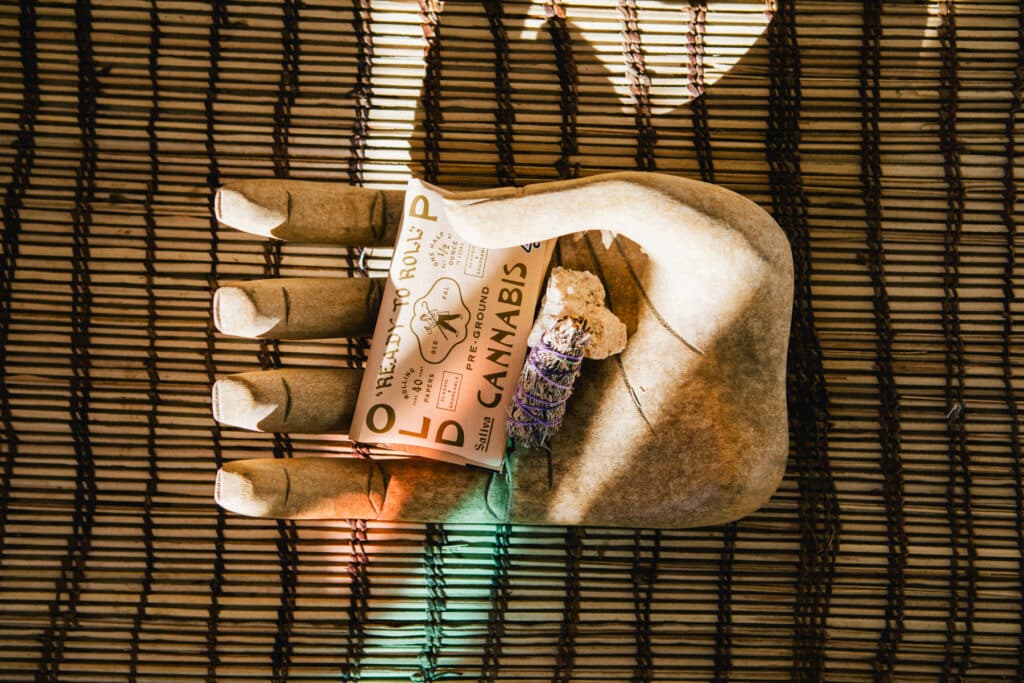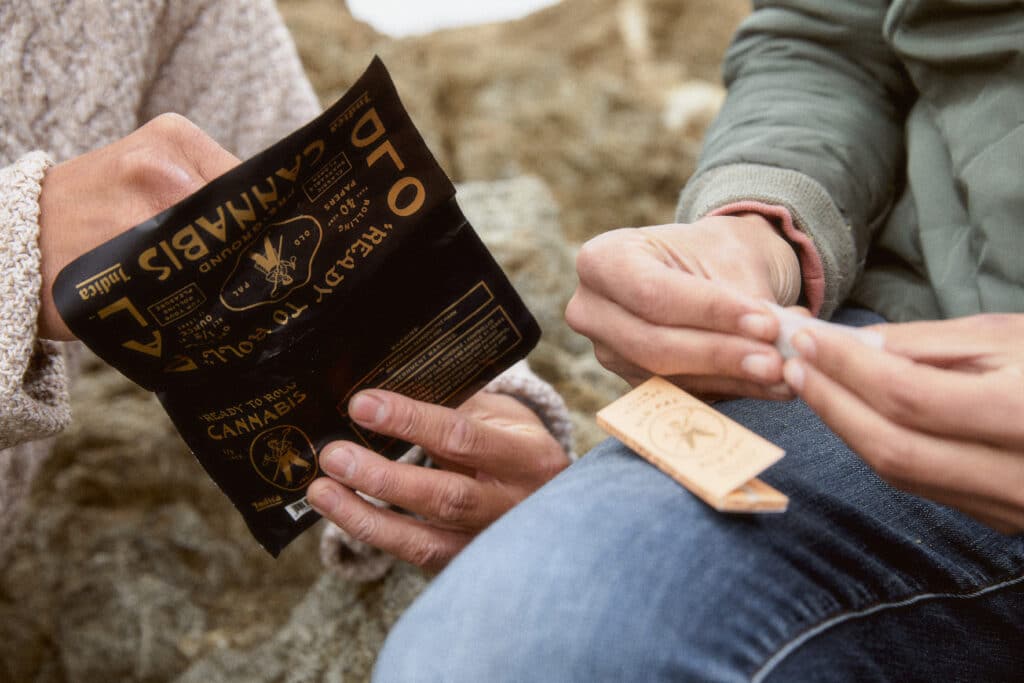Few rituals offer the pleasure and fulfillment of rolling up a joint. First, you select your favorite herb, carefully removing it from the stems. Then, you grind it up to perfection–not too coarse or too fine. The rolling itself is a skill acquired only through patient practice. However, once you get the hang of it, the satisfaction of a well-burning joint is well worth your efforts. The joy of smoking herbs of all kinds has a long, storied history, but we often leave out other complimentary plants that have their own benefits.
When you want added therapeutic value or enjoy a whole joint to yourself without getting too high, consider adding a few other smokable herbs into your routine. To help spark some inspiration, we’ve compiled a list of some of the best smokable herbs to create your own smoking blend.

Smokable Herbs for Blended Joints
Cannabis certainly doesn’t need anything additional. It’s perfect as is, but sometimes a little change is a good thing. So when you want to spice things up (literally), try your hand at rolling up a blended joint with one or more of the following. Each boasts a plethora of unique flavor profiles, terpenes, and benefits that pair well with cannabis. But remember, if you’re smoking some Old Pal flower, we recommend enjoying our high-quality cannabis on its own.
Blue Lotus
Blue lotus has an almost opium-like effect. It’s incredibly relaxing, calming, and excellent for meditation or entering a slight high that lasts for 20-30 minutes. It tastes floral and earthy and can increase other herbs’ effectiveness. It’s often been called “the cannabis of ancient Egypt.”
Parts used: dried flowers
Pairs well with: damiana, skullcap, raspberry leaf
Damiana
Damiana is mainly known to be an aphrodisiac. Historically, early Native Americans drank damiana tea to increase sexual desire and encourage stronger orgasms. When smoked, its calming effects are excellent at replacing anxiety with a mild euphoria. It smells and tastes a little like weed, and offers a relaxing, calming, and slightly sedating effect.
Parts used: dried flowers and leaves
Pairs well with: mugwort, passionflower, mullein, tobacco
Lavender
Lavender is a blissed-out beauty of the botanical world. Its heavenly scent is thanks to linalool, its dominant terpene that’s also heavily present in many cannabis strains. When smoked, lavender reduces stress and anxiety, clears the mind, and promotes peaceful sleep. It tastes fresh and floral and is best used sparingly.
Parts used: dried flowers
Pairs well with: rosemary, sage, rose, chamomile

Mullein
Mullein is often used to treat lung conditions. It’s an expectorant that can help clear the lungs when needed, activate lymph circulation in the neck and chest, and even soothe the throat. In addition, mullein makes an excellent smoking blend base. The flavor and smell are mild, and the texture is light and fluffy, which makes for easy breezy rolling.
Parts used: dried leaves
Pairs well with: damiana, skullcap, mugwort, blue lotus
Mugwort
Mugwort was popularized as a magical herb in the Middle Ages. It’s mildly psychoactive, often producing euphoric and sedative effects. The flavor is fairly neutral, blending well with several herbs and flowers.
Parts used: dried leaves
Pairs well with: damiana, raspberry leaf, lemon balm, peppermint
Peppermint
Peppermint is a widely used smokable herb. The main ingredient, menthol, offers a refreshing, spicy, and cooling flavor. This is best used in moderation, as too much peppermint can burn your throat and cause discomfort. Peppermint is an excellent option for upset stomachs, indigestion, and relaxing breathing. Plus, it just smells good.
Parts used: dried leaves
Pairs well with: mullein, tobacco, catnip, rose
Rose
Ah, what could be sweeter than smoking the beauty that is a rose petal? The color, texture, and aroma alone are enough to leave a lingering flavor of sweet blooming rose gardens. Rose is delicate, calming, and romantic. As a smoking herb, roses provide feelings of inner peace and euphoria.
Parts used: dried petals
Pairs well with: lavender, tobacco, blue lotus, damiana
Skullcap
Skullcap is a noteworthy nervine deeply entrenched in historical Native American culture. It’s used ceremonially for young women coming of age. Although it has hallucinogenic properties in large doses, it’s most beneficial for its ability to relieve nervous tension. In a smoking blend, skullcap is said to help reduce circular thinking and calm the mind.
Parts used: dried leaves and stems
Pairs well with: mullein, blue lotus, white sage, passionflower
Tobacco
Tobacco has plenty of negative associations in our modern culture. Nicotine is a highly addictive substance, especially when paired with chemicals added to commercial cigarettes. Still, pure tobacco is a lovely addition to smoking blends when used in moderation–especially with the woody, earthy notes that can help compliment more floral and aromatic herbs. It’s also profoundly grounding and has centuries of ancient spiritual and ritual purposes.
Parts used: dried leaves
Pairs well with: rose, mugwort, skullcap
White Sage
White sage is a super mood booster. It also aids digestion, relieves headaches, and promotes lucid dreaming. Sage is quite strong on its own and should be used sparingly as a smokable herb. It will add a depth of astringent herbal flavor to your smoking blend.
Parts used: dried leaves
Pairs well with: damiana, raspberry leaf, skullcap, blue lotus

How to Make a Smoking Blend
There are a few easy guidelines for blending smokable herbs. First, decide what you want to blend by picking a base herb, a supportive herb, and a flavoring herb. With your first few blends, it’s best to stick with a simple formula so you can become familiar with the flavor profiles and effects you like. Starting out with too many herbs can give a funky flavor and indistinguishable results.
- A base herb should make up about 40-50% of the blend.
- The action herb is used for its specific effects and comprises 30-40% of the blend.
- Then, flavoring herbs will help elevate the taste and scent and makeup 10-20% of the blend.
There are dozens of smokable herbs that fall into the above categories, but from our list, you can choose any of the following:
- Base herbs: cannabis, damiana, mullein, tobacco
- Action herbs: blue lotus, mugwort, skullcap, white sage
- Flavoring herbs: lavender, peppermint, rose
Like you do with cannabis, simply grind up the herbs in your grinder or use a mortar and pestle. Then, roll up into a joint or blunt and enjoy! Tip: take notes of your recipes and jot down how they taste, smell, and feel. Soon you’ll be a smoking blend master.

Word to the Wise
Herbs are powerful teachers, as well as potent medicine. However, not all herbs are suitable for everyone. Be sure to review any contradictions or adverse reactions that may occur. For example, damiana isn’t suitable for those with a history of breast cancer or diabetes.
Likewise, blue lotus is incredibly powerful and can spur hallucinations in large doses. So just be cautious and do a little research before you start mixing smokable herbs into custom blends.
Finally, be sure to buy your herbs from a trusted source. Shop organic wherever possible and look for companies that are transparent about their harvesting practices. And most importantly, smile and enjoy the moment with your delicious herbal creations.







